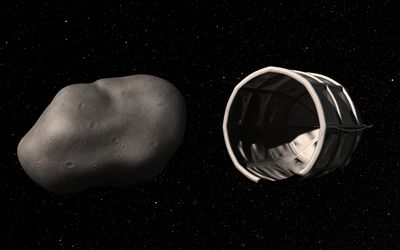The asteroid mining bankby Vidvuds Beldavs
|
| By placing the assays into the reserve accounts of a development bank, the net present value of the recoverable resource can become the reserves against which the Asteroid Mining Bank can lend money to fund industrial projects. |
In the case of mining claims in 1849 California, precise definitions were required where the claim is located. In the case of most asteroids today, existing astronomical naming specifications that include mass and orbital data should be sufficient to define the location of the claim with precision. However, because such location information already exists as published information, it would be insufficient to simply provide astronomical catalog information to establish a claim. The basis of the claim would need to be precise information about the composition of the asteroid that can only be obtained by a visit to the asteroid, including the return of a significant amount of material to the Earth and the placement of an identifying beacon that would signal ownership of the claim.
Registered assays of asteroid resources can become the “Fort Knox” in the sky
The next step in the process would be an assay of the resources of the asteroid. This would allow the asteroid to be “banked,” representing a store of value that the miner can use to finance recovery of the resources, or to fund other activities in space. The assay would establish how much of different minerals can be recovered from a given asteroid with defined methods of recovery and what other value the asteroid may have in the space economy. For example, an asteroid may have the composition, orbit, and other characteristics to serve as a waystation for spacecraft independent of its resources. There may also be scientific value to the asteroid that independent of its mineral resources.
Just as the gold in Fort Knox has value, the value of asteroids established by assays embodies stored value. Perhaps we can refer to the combined value of all the asteroids as a “Fort Knox” in the sky, where the recoverable wealth can back a form of currency. By placing the assays into the reserve accounts of a development bank, the net present value of the recoverable resource can become the reserves against which the Asteroid Mining Bank can lend money to fund industrial projects. Projects would not need to be limited to asteroid mining. The Asteroid Mining Bank could be a source of financing for industrial or economic development activities on the Moon or to fund deployment of the space-based solar power grid that could provide the Earth with clean, carbon-free electrical power.
| The Asteroid Mining Bank could be a source of financing for industrial or economic development activities on the Moon or to fund deployment of the space-based solar power grid that could provide the Earth with clean, carbon-free electrical power. |
The Asteroid Mining Bank will attain greater economic development impact when it is recognized by key central banks. One approach would be to form an association of central banks that would recognize the authority of the Asteroid Mining Bank to emit currency. If either the European Central Bank or the US Federal Reserve recognized this authority it would be sufficient for the Asteroid Mining Bank to begin operation. As other central banks accede to the association, then the Asteroid Mining Bank could emit that currency opening the potential for companies headquartered within the territory to more directly involved in space industrialization activities funded by the Asteroid Mining Bank.
Where to establish the bank?
Unlike the Bretton Woods institutions that were founded in Washington, DC, in the aftermath of World War II, any new permanent global body is unlikely to be established in the US. The world has now become multipolar with a surging Asia and a unifying Europe. The rising new global powers are likely to favor a non-US location for the Asteroid Mining Bank. While Russia’s predecessor, the Soviet Union, was the first country in space, and Russia remains as one of the major spacefaring nations, Russia is unlikely to be seen as the center of space commercialization in coming decades. China has an impressive space program but there may be reluctance on the part of other spacefaring nations to headquarter a key global activity in China. I would like to stake a claim, so to speak, for Riga, Latvia. Latvia is now a thriving part of the European Union and soon will be a member of the European Space Agency. Latvia is clearly in the West, but Riga was also significant as a regional capital in the former Soviet Union and continues to have strong ties to Russia. Latvia is small, with good relations with all spacefaring nations. Latvia could be an ideal headquarters location for the Asteroid Mining Bank.
